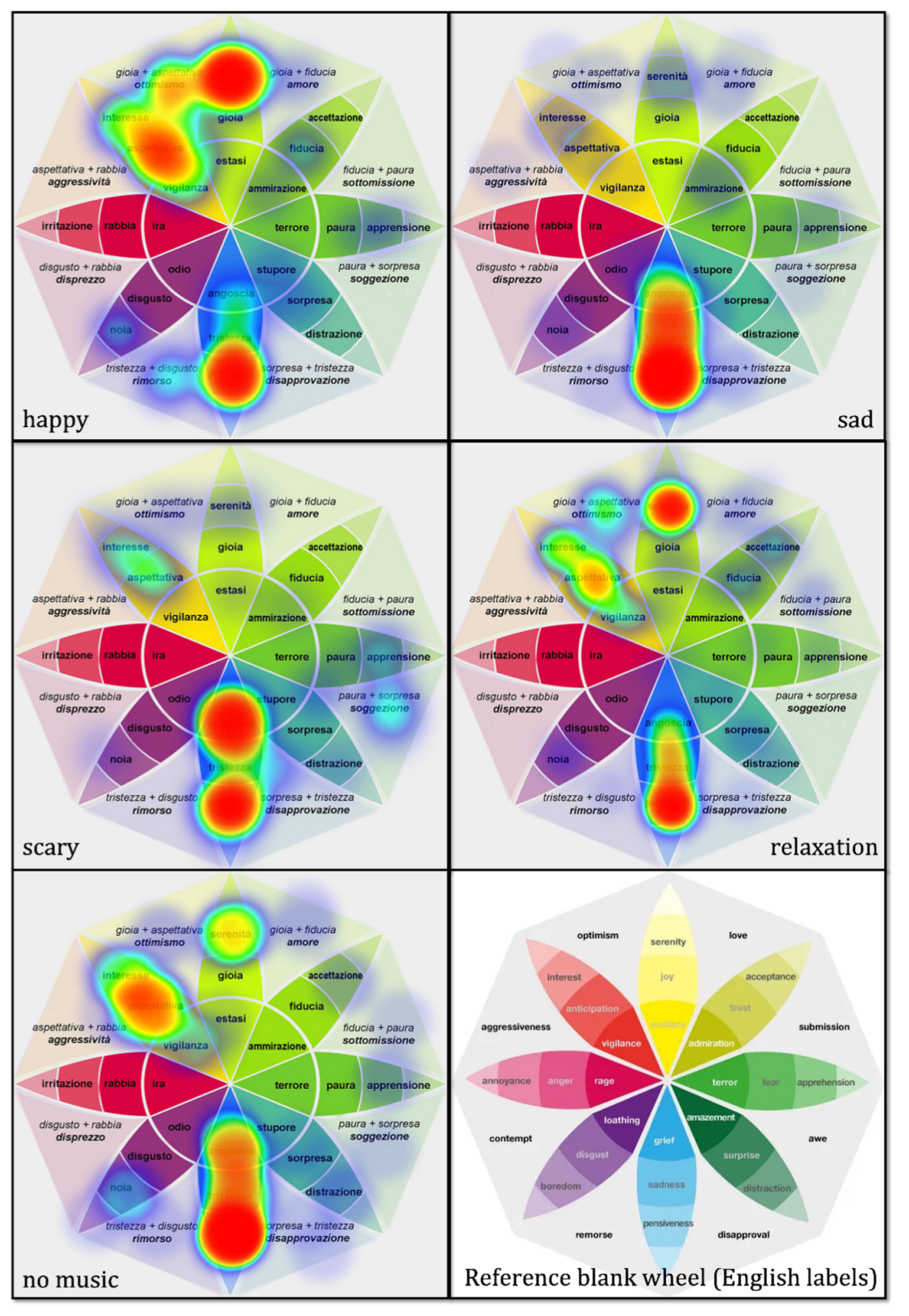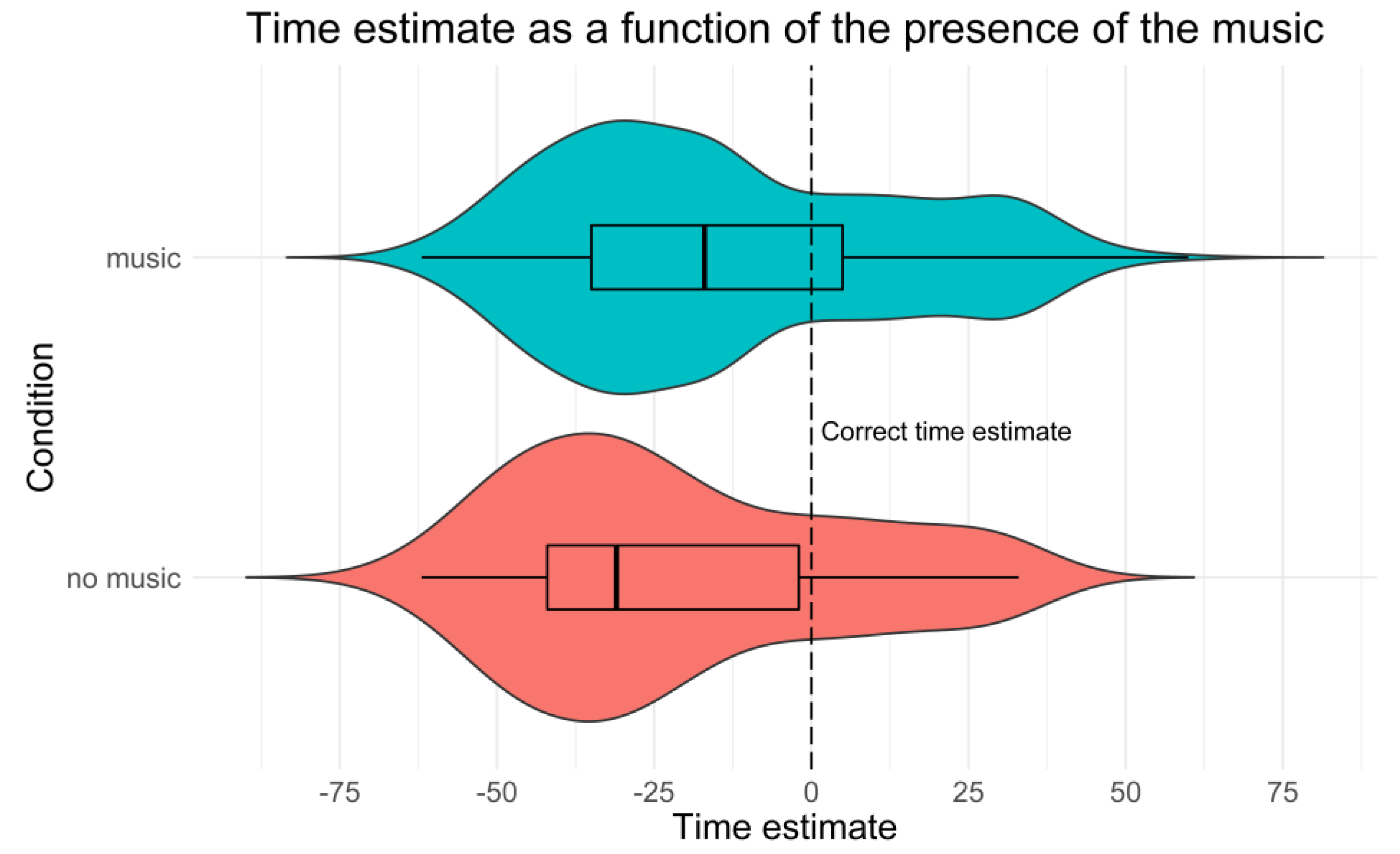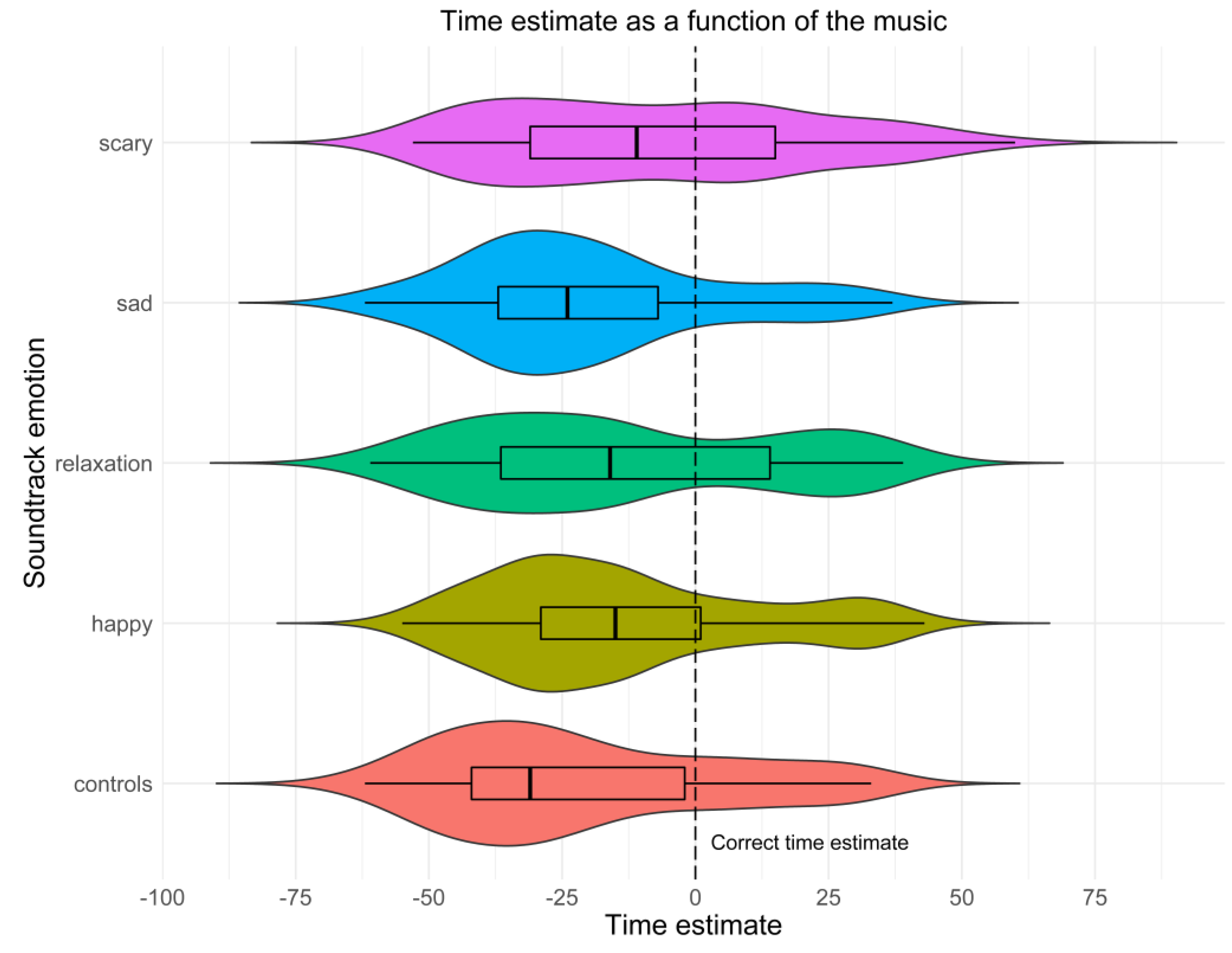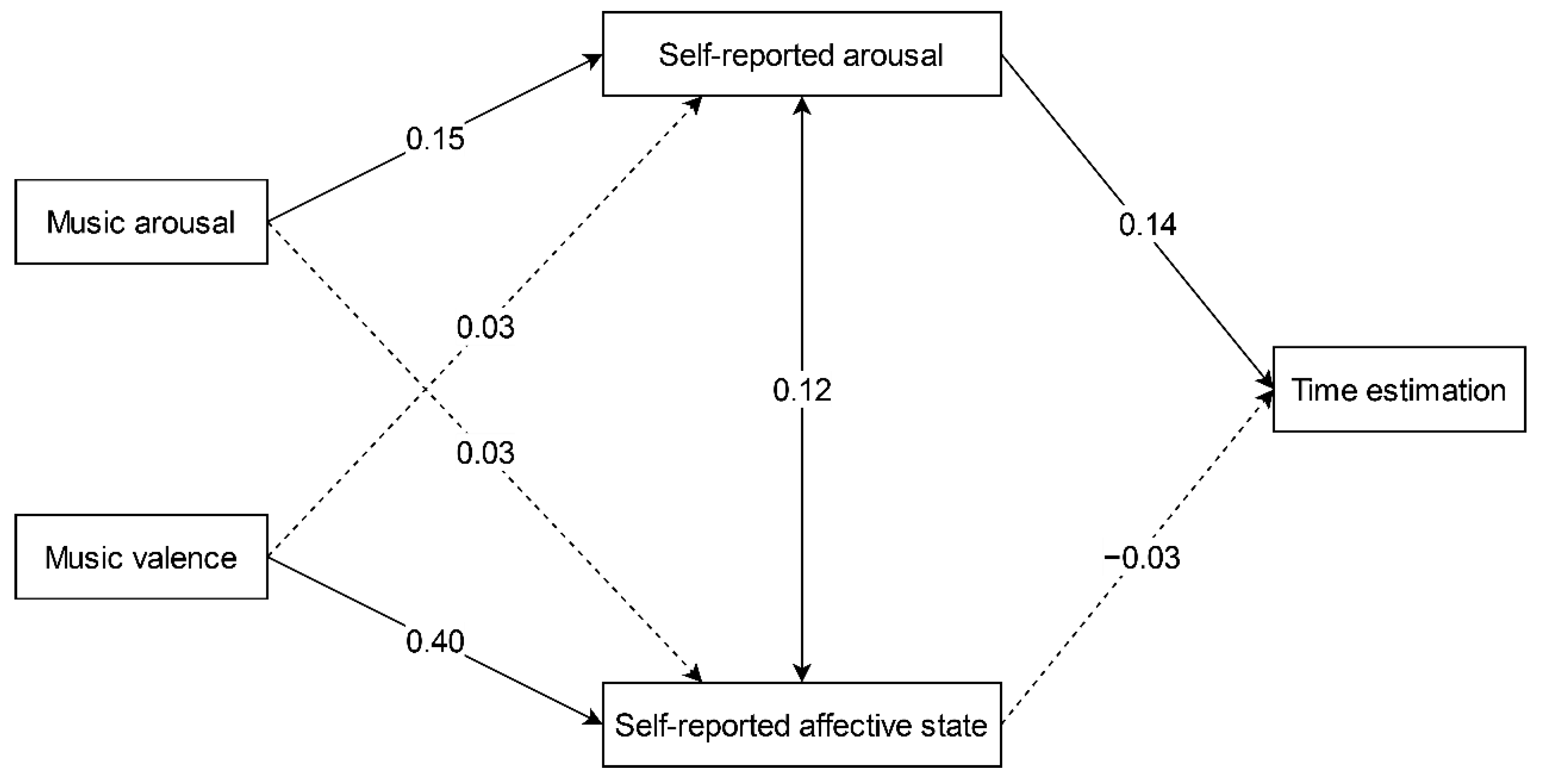Music and Time Perception in Audiovisuals: Arousing Soundtracks Lead to Time Overestimation No Matter Their Emotional Valence
Abstract
1. Introduction
2. Previous Works on Music and Time Perception
Musical Parameters and Time Perception
3. Time Perception in Audiovisuals—Models and Mechanisms
- It is known that certain pieces of music can, through their emotional valence, foster positive affective states, to the point that music has traditionally been considered as a valid mood inductor [68]. Therefore, in accordance with previously collected results from outside of the audiovisual domain [66], we can hypothesize that the positive affect experienced by the recipients while viewing may be negatively correlated with the estimation of the time elapsed [31], that is, the better the viewers feel as they watch the scene (i.e., positive affective state), the less they perceive the passing of time.
- A great deal of research suggests that the arousal (i.e., the physiological and psychological state of activation) conveyed by music might lead to time overestimation [34,54], possibly due to an effect on the internal clock system speed (both in attention- and memory-based models of time perception). Nevertheless, no one, to our knowledge, has ever shown such a phenomenon in an audiovisual domain.
4. The Present Study
4.1. Research Questions
4.2. Method
4.3. Measures
4.3.1. Affective States of the Recipients
4.3.2. Arousal
4.3.3. Time Estimation
4.4. Participants and Preliminary Sample Data Analysis
- An attention check question in which a short Likert scale was presented with the explicit instruction that asked participants to avoid completing it; we excluded all those participants who completed such a scale.
- A time counter on the screen displaying the video was incorporated (it was visible to the experimenters only) so as to exclude all participants who had not watched the whole video (i.e., time spent on that screen < 90 s).
- All those participants who completed the task in less or more than the mean duration ± 3SD were excluded.
- All participants who did not complete the questionnaire in all its parts were also excluded.
4.5. Results
4.5.1. Affective States of the Recipients
4.5.2. Time Estimation
5. Discussion
Limitations
6. Conclusions
Author Contributions
Funding
Institutional Review Board Statement
Informed Consent Statement
Data Availability Statement
Acknowledgments
Conflicts of Interest
References
- Lesiuk, T. The Effect of Music Listening on Work Performance. Psychol. Music 2005, 33, 173–191. [Google Scholar] [CrossRef]
- Nguyen, T.; Grahn, J.A. Mind Your Music: The Effects of Music-Induced Mood and Arousal across Different Memory Tasks. Psychomusicol. Music Mind Brain 2017, 27, 81–94. [Google Scholar] [CrossRef]
- Lehmann, J.A.; Seufert, T. The Influence of Background Music on Learning in the Light of Different Theoretical Perspectives and the Role of Working Memory Capacity. Front. Psychol. 2017, 8, 1902. [Google Scholar] [CrossRef] [PubMed]
- Palazzi, A.; Wagner Fritzen, B.; Gauer, G. Music-Induced Emotion Effects on Decision-Making. Psychol. Music 2018, 47, 621–643. [Google Scholar] [CrossRef]
- Israel, A.; Lahav, E.; Ziv, N. Stop the Music? The Effect of Music on Risky Financial Decisions: An Experimental Study. J. Behav. Exp. Financ. 2019, 24, 100231. [Google Scholar] [CrossRef]
- Mentzoni, R.A.; Laberg, J.C.; Brunborg, G.S.; Molde, H.; Pallesen, S. Type of Musical Soundtrack Affects Behavior in Gambling. J. Behav. Addict. 2014, 3, 102–106. [Google Scholar] [CrossRef] [PubMed]
- Cuesta, U.; Martínez-Martínez, L.; Niño, J.I. A Case Study in Neuromarketing: Analysis of the Influence of Music on Advertising Effectivenes through Eye-Tracking, Facial Emotion and GSR. Eur. J. Soc. Sci. Educ. Res. 2018, 5, 73–82. [Google Scholar] [CrossRef]
- Ansani, A.; D’Errico, F.; Poggi, I. “It Sounds Wrong…” Does Music Affect Moral Judgement? In Computational Science and Its Applications—ICCSA 2017; Gervasi, O., Murgante, B., Misra, S., Borruso, G., Torre, C.M., Rocha, A.M.A.C., Taniar, D., Apduhan, B.O., Stankova, E., Cuzzocrea, A., Eds.; Springer International Publishing: Cham, Switzerland, 2017; Volume 10409, pp. 753–760. ISBN 978-3-319-62406-8. [Google Scholar]
- Ansani, A.; D’Errico, F.; Poggi, I. ‘You Will Be Judged by the Music I Hear’: A Study on the Influence of Music on Moral Judgement. Web Intell. 2019, 17, 53–62. [Google Scholar] [CrossRef]
- Ziv, N. Music and Compliance: Can Good Music Make Us Do Bad Things? Psychol. Music 2015, 44, 953–966. [Google Scholar] [CrossRef]
- Ziv, N.; Hoftman, M.; Geyer, M. Music and Moral Judgment: The Effect of Background Music on the Evaluation of Ads Promoting Unethical Behavior. Psychol. Music 2012, 40, 738–760. [Google Scholar] [CrossRef]
- Strick, M.; de Bruin, H.L.; de Ruiter, L.C.; Jonkers, W. Striking the Right Chord: Moving Music Increases Psychological Transportation and Behavioral Intentions. J. Exp. Psychol. Appl. 2015, 21, 57–72. [Google Scholar] [CrossRef] [PubMed]
- Brown, S.; Theorell, T. The Social Uses of Background Music for Personal Enhancement. In Music and Manipulation: On the Social Uses and Social Control of Music; Berghahn Books: New York, NY, USA; Oxford, UK, 2006; pp. 126–162. [Google Scholar]
- Rai, S. Comparison of Time-Estimation of Music, Noise, Light-Filled and Unfilled Intervals. Indian J. Psychol. 1973, 48, 37–43. [Google Scholar]
- Wang, X.; Wöllner, C. Time as the Ink That Music Is Written with: A Review of Internal Clock Models and Their Explanatory Power in Audiovisual Perception. Jahrb. Musik. 2020, 29, e67. [Google Scholar] [CrossRef]
- Droit-Volet, S.; Fayolle, S.L.; Gil, S. Emotion and Time Perception: Effects of Film-Induced Mood. Front. Integr. Neurosci. 2011, 5, 33. [Google Scholar] [CrossRef] [PubMed]
- Chen, L.; Zhou, X.; Müller, H.J.; Shi, Z. What You See Depends on What You Hear: Temporal Averaging and Crossmodal Integration. J. Exp. Psychol. Gen. 2018, 147, 1851–1864. [Google Scholar] [CrossRef] [PubMed]
- Wallmark, Z.; Nghiem, L.; Marks, L.E. Does Timbre Modulate Visual Perception? Exploring Crossmodal Interactions. Music Percept. 2021, 39, 1–20. [Google Scholar] [CrossRef]
- Jolij, J.; Meurs, M. Music Alters Visual Perception. PLoS ONE 2011, 6, e18861. [Google Scholar] [CrossRef]
- Ansani, A.; Marini, M.; D’Errico, F.; Poggi, I. How Soundtracks Shape What We See: Analyzing the Influence of Music on Visual Scenes Through Self-Assessment, Eye Tracking, and Pupillometry. Front. Psychol. 2020, 11, 2242. [Google Scholar] [CrossRef]
- Boltz, M.G. Auditory Driving in Cinematic Art. Music Percept. 2017, 35, 77–93. [Google Scholar] [CrossRef]
- Herget, A.-K. On Music’s Potential to Convey Meaning in Film: A Systematic Review of Empirical Evidence. Psychol. Music 2019, 49, 21–49. [Google Scholar] [CrossRef]
- Richards, D.; Fassbender, E.; Bilgin, A.; Thompson, W.F. An Investigation of the Role of Background Music in IVWs for Learning. Res. Learn. Technol. 2008, 16, 231–244. [Google Scholar] [CrossRef]
- Berndt, A.; Hartmann, K. The Functions of Music in Interactive Media. In Interactive Storytelling; Spierling, U., Szilas, N., Eds.; Lecture Notes in Computer Science; Springer: Berlin/Heidelberg, Germany, 2008; Volume 5334, pp. 126–131. ISBN 978-3-540-89424-7. [Google Scholar]
- Cassidy, G.; MacDonald, R.A. The Effects of Music on Time Perception and Performance of a Driving Game. Scand. J. Psychol. 2010, 51, 455–464. [Google Scholar] [CrossRef] [PubMed]
- Sanders, T.A.; Cairns, P. Time Perception, Immersion and Music in Videogames; In Proceedings of the Human Computer Interaction (HCI) 2010, Dundee, UK, 6–10 September 2010.
- Savan, A. The Effect of Background Music on Learning. Psychol. Music 1999, 27, 138–146. [Google Scholar] [CrossRef]
- Furnham, A.; Strbac, L. Music Is as Distracting as Noise: The Differential Distraction of Background Music and Noise on the Cognitive Test Performance of Introverts and Extraverts. Ergonomics 2002, 45, 203–217. [Google Scholar] [CrossRef]
- Ziv, N.; Omer, E. Music and Time: The Effect of Experimental Paradigm, Musical Structure and Subjective Evaluations on Time Estimation. Psychol. Music 2011, 39, 182–195. [Google Scholar] [CrossRef]
- Block, R.A. Chapter 9 Experiencing and Remembering Time: Affordances, Context, and Cognition. In Advances in Psychology; Elsevier: Amsterdam, The Netherlands, 1989; Volume 59, pp. 333–363. ISBN 978-0-444-87379-8. [Google Scholar]
- Schäfer, T.; Fachner, J.; Smukalla, M. Changes in the Representation of Space and Time While Listening to Music. Front. Psychol. 2013, 4, 508. [Google Scholar] [CrossRef]
- Block, R.A.; Gruber, R.P. Time Perception, Attention, and Memory: A Selective Review. Acta Psychol. 2014, 149, 129–133. [Google Scholar] [CrossRef]
- North, A.C.; Hargreaves, D.J. Can Music Move People?: The Effects of Musical Complexity and Silence on Waiting Time. Environ. Behav. 1999, 31, 136–149. [Google Scholar] [CrossRef]
- Garlin, F.V.; Owen, K. Setting the Tone with the Tune: A Meta-Analytic Review of the Effects of Background Music in Retail Settings. J. Bus. Res. 2006, 59, 755–764. [Google Scholar] [CrossRef]
- Fang, Z. The Study on the Effect of Background Music on Customer Waiting Time in Restaurant. Open Cybern. Syst. J. 2015, 9, 2163–2167. [Google Scholar] [CrossRef][Green Version]
- McDonnell, J. Music, Scent and Time Preferences for Waiting Lines. Int. J. Bank Mark. 2007, 25, 223–237. [Google Scholar] [CrossRef]
- Oakes, S. Musical Tempo and Waiting Perceptions. Psychol. Mark. 2003, 20, 685–705. [Google Scholar] [CrossRef]
- Guéguen, N.; Jacob, C. The Influence of Music on Temporal Perceptions in an On-Hold Waiting Situation. Psychol. Music 2002, 30, 210–214. [Google Scholar] [CrossRef]
- Areni, C.; Grantham, N. (Waiting) Time Flies When the Tune Flows: Music Influences Affective Responses to Waiting by Changing the Subjective Experience of Passing Time. ACR N. Am. Adv. 2009, 36, 449–455. [Google Scholar]
- Park, J.-S.; Stoel, L.D. How Background Music Affects Consumer Perception of Waiting Time?—A Mediating Role of Emotions. J. Fash. Bus. 2018, 22, 16–29. [Google Scholar] [CrossRef]
- Cameron, M.A.; Baker, J.; Peterson, M.; Braunsberger, K. The Effects of Music, Wait-Length Evaluation, and Mood on a Low-Cost Wait Experience. J. Bus. Res. 2003, 56, 421–430. [Google Scholar] [CrossRef]
- Vaitl, D.; Birbaumer, N.; Gruzelier, J.; Jamieson, G.A.; Kotchoubey, B.; Kübler, A.; Lehmann, D.; Miltner, W.H.R.; Ott, U.; Pütz, P.; et al. Psychobiology of Altered States of Consciousness. Psychol. Bull. 2005, 131, 98–127. [Google Scholar] [CrossRef] [PubMed]
- Gabrielsson, A.; Wik, S.L. Strong Experiences Related to Music: Adescriptive System. Musicae Sci. 2003, 7, 157–217. [Google Scholar] [CrossRef]
- North, A.C.; Hargreaves, D.J.; Heath, S.J. Musical Tempo and Time Perception in a Gymnasium. Psychol. Music 1998, 26, 78–88. [Google Scholar] [CrossRef]
- Kellaris, J.J.; Altsech, M.B. The Experience of Time as a Function of Musical Loudness and Gender of Listener. ACR N. Am. Adv. 1992, 19, 725–729. [Google Scholar]
- Droit-Volet, S.; Ramos, D.; Bueno, J.L.O.; Bigand, E. Music, Emotion, and Time Perception: The Influence of Subjective Emotional Valence and Arousal? Front. Psychol. 2013, 4, 417. [Google Scholar] [CrossRef] [PubMed]
- Bueno, J.L.O.; Firmino, E.A.; Engelman, A. Influence of Generalized Complexity of a Musical Event on Subjective Time Estimation. Percept. Mot. Ski. 2002, 94, 541–547. [Google Scholar] [CrossRef] [PubMed]
- Caldwell, C.; Hibbert, S.A. Play That One Again: The Effect of Music Tempo on Consumer Behaviour in a Restaurant. ACR Eur. Adv. 1999, 4, 58–62. [Google Scholar]
- Kellaris, J.J.; Kent, R.J. Exploring Tempo and Modality Effects, on Consumer Responses to Music. ACR N. Am. Adv. 1991, 18, 243–248. [Google Scholar]
- Bueno, J.L.O.; Ramos, D. Musical Mode and Estimation of Time. Percept. Mot. Ski. 2007, 105, 1087–1092. [Google Scholar] [CrossRef]
- Lahdelma, I.; Eerola, T. Single Chords Convey Distinct Emotional Qualities to Both Naïve and Expert Listeners. Psychol. Music 2016, 44, 37–54. [Google Scholar] [CrossRef]
- Kellaris, J.J.; Kent, R.J. The Influence of Music on Consumers’ Temporal Perceptions: Does Time Fly When You’re Having Fun? J. Consum. Psychol. 1992, 1, 365–376. [Google Scholar] [CrossRef]
- Yalch, R.F.; Spangenberg, E.R. The Effects of Music in a Retail Setting on Real and Perceived Shopping Times. J. Bus. Res. 2000, 49, 139–147. [Google Scholar] [CrossRef]
- Kellaris, J.J.; Mantel, S.P. Shaping Time Perceptions with Background Music: The Effect of Congruity and Arousal on Estimates of Ad Durations. Psychol. Mark. 1996, 13, 501–515. [Google Scholar] [CrossRef]
- Zakay, D. Chapter 10 Subjective Time and Attentional Resource Allocation: An Integrated Model of Time Estimation. In Advances in Psychology; Elsevier: Amsterdam, The Netherlands, 1989; Volume 59, pp. 365–397. ISBN 978-0-444-87379-8. [Google Scholar]
- Jones, M.R.; Boltz, M. Dynamic Attending and Responses to Time. Psychol. Rev. 1989, 96, 459–491. [Google Scholar] [CrossRef]
- Gibbon, J. Scalar Expectancy Theory and Weber’s Law in Animal Timing. Psychol. Rev. 1977, 84, 279. [Google Scholar] [CrossRef]
- Hammerschmidt, D.; Wöllner, C. Sensorimotor Synchronization with Higher Metrical Levels in Music Shortens Perceived Time. Music Percept. 2020, 37, 263–277. [Google Scholar] [CrossRef]
- Droit-Volet, S.; Fayolle, S.; Lamotte, M.; Gil, S. Time, Emotion and the Embodiment of Timing. Timing Time Percept. 2013, 1, 99–126. [Google Scholar] [CrossRef]
- Wang, S.; Shi, Z. Temporal Entrainment Effect: Can Music Enhance Our Attention Resolution in Time? [poster presentation]. In Proceedings of the 12th International Conference of Students of Systematic Musicology, SysMus, Berlin, Germany, 10–12 September 2019. [Google Scholar]
- Ortega, L.; López, F. Effects of Visual Flicker on Subjective Time in a Temporal Bisection Task. Behav. Process. 2008, 78, 380–386. [Google Scholar] [CrossRef] [PubMed]
- Ornstein, R.E. On the Experience of Time; Penguin: Harmondsworth, UK, 1975. [Google Scholar]
- Polti, I.; Martin, B.; van Wassenhove, V. The Effect of Attention and Working Memory on the Estimation of Elapsed Time. Sci Rep. 2018, 8, 6690. [Google Scholar] [CrossRef]
- Droit-Volet, S.; Bigand, E.; Ramos, D.; Bueno, J.L.O. Time Flies with Music Whatever Its Emotional Valence. Acta Psychol. 2010, 135, 226–232. [Google Scholar] [CrossRef]
- Herbert, R. Everyday Music Listening: Absorption, Dissociation and Trancing; Routledge: London, UK, 2016; ISBN 978-1-4724-8060-6. [Google Scholar]
- Bisson, N.; Tobin, S.; Grondin, S. Remembering the Duration of Joyful and Sad Musical Excerpts: Assessment with Three Estimation Methods. NeuroQuantology 2009, 7, 46–57. [Google Scholar] [CrossRef][Green Version]
- Boltz, M.G. Tempo Discrimination of Musical Patterns: Effects Due to Pitch and Rhythmic Structure. Percept. Psychophys. 1998, 60, 1357–1373. [Google Scholar] [CrossRef]
- Västfjäll, D. Emotion Induction through Music: A Review of the Musical Mood Induction Procedure. Musicae Sci. 2001, 5, 173–211. [Google Scholar] [CrossRef]
- Macdiarmid, C. On Lockdown [Short Movie]. Available online: https://vimeo.com/435128203 (accessed on 27 October 2021).
- Elliott, D.; Polman, R.; McGregor, R. Relaxing Music for Anxiety Control. J. Music Ther. 2011, 48, 264–288. [Google Scholar] [CrossRef]
- Juslin, P.N.; Laukka, P. Expression, Perception, and Induction of Musical Emotions: A Review and a Questionnaire Study of Everyday Listening. J. New Music Res. 2004, 33, 217–238. [Google Scholar] [CrossRef]
- Cespedes-Guevara, J.; Eerola, T. Music Communicates Affects, Not Basic Emotions—A Constructionist Account of Attribution of Emotional Meanings to Music. Front. Psychol. 2018, 9, 215. [Google Scholar] [CrossRef] [PubMed]
- Quinto, L.; Thompson, W.F.; Taylor, A. The Contributions of Compositional Structure and Performance Expression to the Communication of Emotion in Music. Psychol. Music 2014, 42, 503–524. [Google Scholar] [CrossRef]
- Fabian, D.; Schubert, E. Expressive Devices and Perceived Musical Character in 34 Performances of Variation 7 from Bach’s Goldbergvariations. Musicae Sci. 2003, 7, 49–71. [Google Scholar] [CrossRef]
- Scherer, K.R.; Sundberg, J.; Tamarit, L.; Salomão, G.L. Comparing the Acoustic Expression of Emotion in the Speaking and the Singing Voice. Comput. Speech Lang. 2015, 29, 218–235. [Google Scholar] [CrossRef]
- Eerola, T.; Friberg, A.; Bresin, R. Emotional Expression in Music: Contribution, Linearity, and Additivity of Primary Musical Cues. Front. Psychol. 2013, 4, 487. [Google Scholar] [CrossRef]
- Grimm, E.M.; Van Everdingen, R.; Schöpping, M. Toward a Recommendation for a European Standard of Peak and LKFS Loudness Levels. SMPTE Motion Imaging J. 2010, 119, 28–34. [Google Scholar] [CrossRef]
- Plutchik, R. A general psychoevolutionary theory of emotion. In Theories of Emotion; Elsevier: Amsterdam, The Netherlands, 1980; pp. 3–33. ISBN 978-0-12-558701-3. [Google Scholar]
- Muthén, L.K.; Muthén, B. Mplus User’s Guide: Statistical Analysis with Latent Variables, User’s Guide; Muthén & Muthén: Los Angeles, CA, USA, 2017; ISBN 0-9829983-2-5. [Google Scholar]
- Hu, L.; Bentler, P.M. Cutoff Criteria for Fit Indexes in Covariance Structure Analysis: Conventional Criteria versus New Alternatives. Struct. Equ. Modeling A Multidiscip. J. 1999, 6, 1–55. [Google Scholar] [CrossRef]
- Stratton, V.N. Influence of Music and Socializing on Perceived Stress While Waiting. Percept. Mot. Ski. 1992, 75, 334. [Google Scholar] [CrossRef]
- Cohen, A.J. Congruence-Association Model of Music and Multimedia: Origin and Evolution. Psychol. Music Multimed. 2013, 17–47. [Google Scholar]
- Vitouch, O. When Your Ear Sets the Stage: Musical Context Effects in Film Perception. Psychol. Music 2001, 29, 70–83. [Google Scholar] [CrossRef]
- Boltz, M.G. The Cognitive Processing of Film and Musical Soundtracks. Mem. Cogn. 2004, 32, 1194–1205. [Google Scholar] [CrossRef] [PubMed]
- Boltz, M.G. Musical Soundtracks as a Schematic Influence on the Cognitive Processing of Filmed Events. Music Percept. 2001, 18, 427–454. [Google Scholar] [CrossRef]
- Flaherty, M.G. A Watched Pot: How We Experience Time; NYU Press: New York, NY, USA, 1999; ISBN 0-8147-2687-9. [Google Scholar]
- Husserl, E. The Phenomenology of Internal Time-Consciousness; Heidegger, M., Ed.; Indiana University Press: Bloomington, Indiana, 2019; ISBN 978-0-253-04199-9. [Google Scholar]
- Ciavatta, D. 8. Merleau-Ponty and the Phenomenology of Natural Time. In Perception and its Development in Merleau-Ponty’s Phemenology; Jacobson, K., Russon, J., Eds.; University of Toronto Press: Toronto, ON, Canada, 2017; pp. 159–190. ISBN 978-1-4875-1285-9. [Google Scholar]
- Shen, Y. The Trio of Time: On Merleau-Ponty’s Phenomenology of Time. Hum. Stud. 2021. [Google Scholar] [CrossRef]
- Holmer Nadesan, M.; Flaherty, M.G. A Watched Pot: How We Experience Time [book review]. Hum. Stud. 2002, 25, 257–265. [Google Scholar] [CrossRef]
- Zentner, M.; Eerola, T. Self-report measures and models. In Handbook of Music and Emotion: Theory, Research, Applications; Oxford University Press: Oxford, UK, 2010; pp. 187–221. [Google Scholar]
- Ribeiro, F.S.; Santos, F.H.; Albuquerque, P.B.; Oliveira-Silva, P. Emotional Induction Through Music: Measuring Cardiac and Electrodermal Responses of Emotional States and Their Persistence. Front. Psychol. 2019, 10, 451. [Google Scholar] [CrossRef] [PubMed]
- White, E.L.; Rickard, N.S. Emotion Response and Regulation to “Happy” and “Sad” Music Stimuli: Partial Synchronization of Subjective and Physiological Responses. Musicae Sci. 2016, 20, 11–25. [Google Scholar] [CrossRef]
- Krumhansl, C.L. An Exploratory Study of Musical Emotions and Psychophysiology. Can. J. Exp. Psychol./Rev. Can. Psychol. Expérimentale 1997, 51, 336–353. [Google Scholar] [CrossRef]
- Lundqvist, L.-O.; Carlsson, F.; Hilmersson, P.; Juslin, P.N. Emotional Responses to Music: Experience, Expression, and Physiology. Psychol. Music 2009, 37, 61–90. [Google Scholar] [CrossRef]
- van der Zwaag, M.D.; Westerink, J.H.D.M.; van den Broek, E.L. Emotional and Psychophysiological Responses to Tempo, Mode, and Percussiveness. Musicae Sci. 2011, 15, 250–269. [Google Scholar] [CrossRef]
- Lynar, E.; Cvejic, E.; Schubert, E.; Vollmer-Conna, U. The Joy of Heartfelt Music: An Examination of Emotional and Physiological Responses. Int. J. Psychophysiol. 2017, 120, 118–125. [Google Scholar] [CrossRef] [PubMed]
- Ellis, R.J.; Simons, R.F. The Impact of Music on Subjective and Physiological Indices of Emotion While Viewing Films. Psychomusicol. J. Res. Music Cogn. 2005, 19, 15–40. [Google Scholar] [CrossRef]
- Hodges, D.A. Psychophysiological measures. In Handbook of Music and Emotion: Theory, Research, Applications; Oxford University Press: Oxford, UK, 2010; pp. 279–311. [Google Scholar]
- Bailey, N.; Areni, C.S. When a Few Minutes Sound like a Lifetime: Does Atmospheric Music Expand or Contract Perceived Time? J. Retail. 2006, 82, 189–202. [Google Scholar] [CrossRef]
- Herget, A.-K.; Schramm, H.; Breves, P. Development and Testing of an Instrument to Determine Musical Fit in Audio–Visual Advertising. Musicae Sci. 2018, 22, 362–376. [Google Scholar] [CrossRef]
- Herget, A.-K.; Breves, P.; Schramm, H. The Influence of Different Levels of Musical Fit on the Efficiency of Audio-Visual Advertising. Musicae Sci. 2020, 1029864920904095. [Google Scholar] [CrossRef]
- Boltz, M.G.; Ebendorf, B.; Field, B. Audiovisual Interactions: The Impact of Visual Information on Music Perception and Memory. Music Percept. 2009, 27, 43–59. [Google Scholar] [CrossRef]
- Nichols, R. Ravel; Yale University Press: New Haven, CT, USA, 2011; ISBN 0-300-10882-6. [Google Scholar]





| Factor | Effect | Reference |
|---|---|---|
| Attention | overestimation | [63] |
| Engagement | overestimation | [31] |
| Arousal | overestimation | [16,59,64] |
| Arousal | underestimation | [65] |
| Negative emotions | overestimation | [66] |
| Positive emotions | underestimation | [66] |
| Music familiarity | underestimation | [53] |
| Liked vs. disliked music | underestimation | [39] |
| Fast musical tempo | overestimation | [58,60] |
| Slow musical tempo | underestimation | [37,48,49] |
| Volume | overestimation | [45] |
| Pitch and metrical variations | overestimation | [67] |
| Musical structure complexity | overestimation | [47] |
| Stimulus complexity | overestimation | [62] |
| Locrian mode (vs. Ionian and Aeolian) | overestimation | [50] |
| Major mode | overestimation | [52] |
| Minor mode | underestimation | [52] |
| Track | Emotion | Valence | Arousal |
|---|---|---|---|
| Appalachian spring (VII: doppio movimento) [A. Copland] | happiness | + | + |
| After Celan [D. Darling and K. Bjørnstad] | sadness | - | - |
| Murder [Newton Brothers] | fear | - | + |
| World’s most relaxing music [R. Wiseman] | relaxation | + | - |
| Affective State | |||
|---|---|---|---|
| Soundtrack | Negative | Neutral | Positive |
| happy | 35.96% | 23.68% | 40.35% |
| relaxation | 41.18% | 21.85% | 36.97% |
| no music | 64.42% | 21.15% | 14.42% |
| sad | 84.68% | 6.31% | 9.01% |
| scary | 78.63% | 13.68% | 7.69% |
| Soundtrack | Mean (s) | SD | N |
|---|---|---|---|
| happy | −14.00 | 24.74 | 114 |
| relaxation | −13.28 | 28.88 | 119 |
| no music | −21.03 | 26.10 | 104 |
| sad | −20.16 | 23.65 | 111 |
| scary | −7.37 | 29.08 | 117 |
| Total | −14.98 | 27.01 | 565 |
Publisher’s Note: MDPI stays neutral with regard to jurisdictional claims in published maps and institutional affiliations. |
© 2021 by the authors. Licensee MDPI, Basel, Switzerland. This article is an open access article distributed under the terms and conditions of the Creative Commons Attribution (CC BY) license (https://creativecommons.org/licenses/by/4.0/).
Share and Cite
Ansani, A.; Marini, M.; Mallia, L.; Poggi, I. Music and Time Perception in Audiovisuals: Arousing Soundtracks Lead to Time Overestimation No Matter Their Emotional Valence. Multimodal Technol. Interact. 2021, 5, 68. https://doi.org/10.3390/mti5110068
Ansani A, Marini M, Mallia L, Poggi I. Music and Time Perception in Audiovisuals: Arousing Soundtracks Lead to Time Overestimation No Matter Their Emotional Valence. Multimodal Technologies and Interaction. 2021; 5(11):68. https://doi.org/10.3390/mti5110068
Chicago/Turabian StyleAnsani, Alessandro, Marco Marini, Luca Mallia, and Isabella Poggi. 2021. "Music and Time Perception in Audiovisuals: Arousing Soundtracks Lead to Time Overestimation No Matter Their Emotional Valence" Multimodal Technologies and Interaction 5, no. 11: 68. https://doi.org/10.3390/mti5110068
APA StyleAnsani, A., Marini, M., Mallia, L., & Poggi, I. (2021). Music and Time Perception in Audiovisuals: Arousing Soundtracks Lead to Time Overestimation No Matter Their Emotional Valence. Multimodal Technologies and Interaction, 5(11), 68. https://doi.org/10.3390/mti5110068







